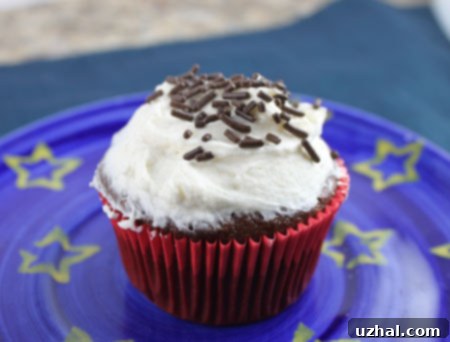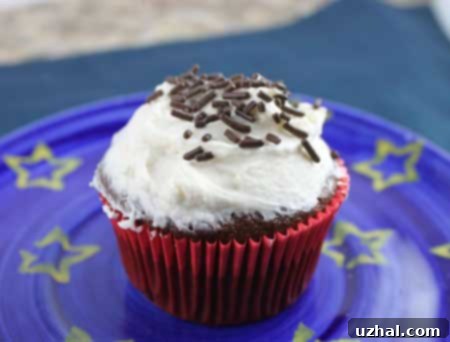Effortless Chocolate Cupcakes with Velvety Flour-Based Ermine Frosting (No Powdered Sugar!)
Prepare to discover a truly remarkable dessert that challenges conventional baking wisdom: Quick Chocolate Cupcakes crowned with a luscious, flour-based frosting. While the name might initially sound unconventional, the results are anything but. These easy-to-make cupcakes feature a rich, moist chocolate base crafted with simple ingredients like vegetable oil and cocoa powder. What truly sets them apart, however, is the innovative frosting – a smooth, clean-tasting delight made entirely without confectioners’ sugar. Perfect for those moments when your powdered sugar supply is low, or you simply crave a less intensely sweet, yet equally indulgent, topping, this recipe promises a delightful experience from start to finish.
The Magic of Flour-Based Frosting: Introducing Ermine Frosting
So, what exactly is this “flour-based frosting” that bypasses the need for powdered sugar? Often affectionately known as Ermine Frosting, Boiled Milk Frosting, or even “Gravy Frosting” due to its initial preparation, this classic technique yields an incredibly smooth, buttery, and subtly sweet topping that has stood the test of time. Unlike traditional buttercream that relies heavily on powdered sugar for its structure and sweetness, Ermine Frosting achieves its velvety texture through a cooked flour and milk paste, which is then whipped into butter and granulated sugar.
The process begins by whisking flour and milk together, then gently boiling the mixture until it thickens into a pudding-like consistency. This cooked paste, often referred to as a roux, is the secret behind the frosting’s unique structure. After allowing this paste to cool completely (and we mean completely – warmth is the enemy of a perfect Ermine Frosting!), it’s gradually added to creamed butter and granulated sugar. The magic happens as these components are whipped together, transforming into a light, airy, and wonderfully stable frosting that’s surprisingly easy to work with once you understand the technique.
Why Opt for Frosting Without Confectioners’ Sugar?
My journey to creating this frosting began out of necessity – a day when I urgently needed frosting but had no confectioners’ sugar in sight. What started as a problem quickly became a revelation. The absence of powdered sugar not only makes this recipe incredibly resourceful, but it also offers distinct advantages that set it apart from its conventional counterparts. One of the most notable benefits is its clean, pure flavor. Without the sometimes cloying sweetness or slight grittiness that powdered sugar can impart, Ermine Frosting allows the natural flavors of butter and vanilla (or whatever flavorings you choose) to shine through beautifully.
Achieving the desired smoothness requires ample whipping time to ensure the granulated sugar fully dissolves. While this might sound daunting, a stand mixer makes the process remarkably simple, effortlessly transforming what might otherwise be a grainy mixture into a slick, elegant topping. The texture is akin to a classic buttercream – light, airy, and spreadable – yet with its own unique character. Another significant advantage for many bakers is that this recipe is entirely egg-free, making it a suitable option for those with egg allergies or dietary preferences. It’s a fantastic alternative for anyone seeking a delightful frosting that offers a refreshing departure from the usual.
Beyond its unique texture and taste, Ermine Frosting offers practicality. It removes the powdery mess often associated with working with confectioners’ sugar, a small but appreciated detail in any kitchen. Furthermore, because it’s less sweet than many traditional buttercreams, it perfectly complements rich desserts like these chocolate cupcakes, creating a balanced and harmonious flavor profile that allows both the cake and the frosting to be fully appreciated without overwhelming the palate. It’s truly a versatile and highly rewarding frosting to master, opening up new possibilities for your baking adventures.
Crafting Your Perfect Quick Chocolate Cupcakes
While the flour-based frosting certainly steals some of the spotlight, the chocolate cupcakes themselves are equally exceptional. These are not just any chocolate cupcakes; they are incredibly moist, wonderfully light, and surprisingly simple to whip up from scratch. The recipe utilizes common pantry staples, making it a go-to for impromptu baking sessions or when you need a reliable dessert in a pinch. The use of vegetable oil instead of butter in the cake batter contributes significantly to their superior moisture and tender crumb, ensuring they remain soft and delicious for days.
One ingredient that might raise an eyebrow is lemon juice. Rest assured, you won’t taste any lemon in the final cupcake! Its role is purely scientific: it acts as an acid that reacts with the baking soda, creating tiny air pockets that give the cupcakes their characteristic lightness and airy texture. This subtle chemical reaction is crucial for achieving that perfect, tender crumb that everyone loves. The rich cocoa powder provides an intense chocolate flavor without being overly sweet, creating a balanced base that pairs exquisitely with the unique frosting.
This simple scratch cupcake recipe is also incredibly versatile. Its robust structure and balanced flavor make it an excellent foundation for experimentation. Whether you’re looking to explore different fillings like fruit curds or ganaches, or trying out various frosting flavors and techniques (perhaps finally conquering that true buttercream!), this chocolate cupcake recipe will serve as a reliable and delicious starting point. It’s a wonderful addition to any baker’s repertoire, providing a consistent and delightful outcome every time.
Tips for Perfect Cupcakes Every Time:
- **Measure Accurately:** Especially for flour and cocoa, use a kitchen scale for best results or the spoon-and-level method to avoid dense cupcakes.
- **Don’t Overmix:** Overmixing develops gluten, leading to tough cupcakes. Mix just until ingredients are combined.
- **Room Temperature Ingredients:** Ensure milk and egg are at room temperature for a smoother, more emulsified batter.
- **Fill Liners Properly:** Fill cupcake liners about two-thirds full to prevent overflow and ensure even baking.
- **Cool Completely:** Always allow cupcakes to cool fully before frosting. Warm cupcakes will melt your beautiful Ermine Frosting!
Elevate Your Baking with These Related Recipes:
- Six Inch White Chocolate Cake
- German Buttercream Cream Cheese Icing
- Jumbo Double Chocolate Cookies
- The Best Yellow Cupcakes
- Six Inch White Cake aka Birthday Cake
Recipe

Quick Chocolate Cupcakes with Flour Based Frosting
Cookie Madness
Pin Recipe
Ingredients
For the Chocolate Cupcakes:
- ⅔ cup whole milk
- 2 tablespoons lemon juice
- ¼ cup vegetable oil
- ¾ cup granulated sugar
- 1 large egg
- 1 teaspoon vanilla extract
- ¼ teaspoon salt
- 1 teaspoon baking soda
- ⅓ cup unsweetened natural cocoa powder
- 1 cup all-purpose flour sifted after measuring (approx. 4.5 oz)
For the Flour-Based (Ermine) Frosting:
- 5 tablespoons all-purpose flour
- 1 cup whole milk
- 2 sticks unsalted butter (at room temperature)
- 1 cup granulated sugar
- 1-2 teaspoons vanilla extract
- Pinch of salt
Instructions
For the Chocolate Cupcakes:
-
Preheat your oven to 350 degrees F (175 C) and line a 12-cup muffin tin with paper liners.
-
In a small bowl, mix together the whole milk and lemon juice. Set this mixture aside to curdle for a few minutes; it will resemble buttermilk.
-
In a large mixing bowl, beat the vegetable oil and ¾ cup granulated sugar with an electric mixer until light and smooth.
-
Beat in the egg, vanilla extract, ¼ teaspoon salt, and baking soda until all ingredients are well blended and the mixture is fluffy. Add the ⅓ cup cocoa powder and beat until fully incorporated. With a large mixing spoon or rubber scraper, gently stir in the sifted all-purpose flour alternately with the milk-lemon juice mixture, beginning and ending with flour, until the flour is just absorbed and the batter is smooth. Be careful not to overmix.
-
Divide the batter evenly among the 12 paper-lined cupcake cups, filling each approximately two-thirds full.
-
Bake at 350 degrees F (175 C) for 25 minutes, or until a wooden toothpick inserted into the center of a cupcake comes out clean.
-
Allow the cupcakes to cool in the muffin pan on a wire rack for about 20 minutes before carefully removing them to the platter to cool completely. Ensuring they are fully cool is crucial before applying the frosting.
For the Flour-Based (Ermine) Frosting:
-
In a small saucepan, whisk together the 5 tablespoons of flour and 1 cup of whole milk until smooth. Cook over medium heat, stirring constantly with a whisk, until the mixture starts to thicken significantly and resembles a very thick pudding or paste. Continue cooking and stirring for 1-2 minutes more to ensure the flour is fully cooked. Transfer this flour mixture into a clean dish, press plastic wrap directly onto the surface to prevent a skin from forming, and let it cool completely to room temperature. This can take a couple of hours or can be done ahead of time and refrigerated.
-
In a large mixing bowl (preferably using a stand mixer with a paddle attachment), beat together the 2 sticks of room temperature unsalted butter and 1 cup of granulated sugar until light, fluffy, and the sugar is mostly dissolved (this will take several minutes). Then, gradually add the cooled flour-milk paste, about 2 tablespoons at a time, beating well after each addition. Continue to beat on medium-high speed for an extended period, probably 6 to 10 minutes, until the frosting transforms from a grainy texture into a creamy, light, and velvety consistency. The long whipping time is essential for dissolving the sugar and achieving the characteristic Ermine texture. Finally, beat in the 1-2 teaspoons of vanilla extract and a pinch of salt until everything is light and creamy.
-
Frost the completely cooled cupcakes immediately. You can keep frosted cupcakes in the refrigerator; simply allow them to come to room temperature for about 30 minutes before serving for the best texture. I’ve also found that a few left in a sealed container at room temperature overnight maintained their excellent quality. Enjoy your homemade, delightful treat!
